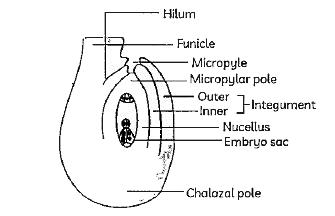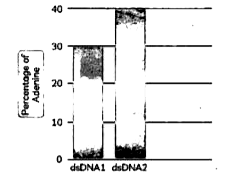The tension in the DNA strands created by unwinding of DNA is release by:
a) DNA polymerase II
b) DNA polymerase III
c) Helicase
d) Topoisomerase
DNA polymerase II
DNA polymerase III
Helicase
Topoisomerase
The correct Answer is:D
To solve the question regarding which enzyme releases the tension in the DNA strands created by unwinding, we can follow these steps:
1. Understanding DNA Structure:
- DNA is a double-stranded helix, and during processes like replication, the strands need to be unwound to allow access to the genetic information.
2. Identifying the Problem:
- When the DNA strands are unwound, it creates tension in the form of supercoiling ahead of the replication fork. This tension needs to be relieved to prevent the DNA from becoming too tightly coiled.
3. Role of Enzymes in DNA Replication:
- Several enzymes are involved in DNA replication:
- DNA Polymerase II: Involved in DNA repair and replication.
- DNA Polymerase III: The primary enzyme for DNA replication in prokaryotes.
- Helicase: Unwinds the DNA double helix, creating the replication fork.
4. Identifying the Correct Enzyme:
- While helicase unwinds the DNA, it does not relieve the tension created by this unwinding. The enzyme responsible for relieving this tension is Topoisomerase. Topoisomerase works by cutting the DNA strands, allowing them to unwind and then rejoining them, thus relieving the tension.
5. Conclusion:
- Based on the roles of the enzymes discussed, the correct answer to the question is Topoisomerase (d).
Final Answer:
d) Topoisomerase
---
- DNA is a double-stranded helix, and during processes like replication, the strands need to be unwound to allow access to the genetic information.
- When the DNA strands are unwound, it creates tension in the form of supercoiling ahead of the replication fork. This tension needs to be relieved to prevent the DNA from becoming too tightly coiled.
- Several enzymes are involved in DNA replication:
- DNA Polymerase II: Involved in DNA repair and replication.
- DNA Polymerase III: The primary enzyme for DNA replication in prokaryotes.
- Helicase: Unwinds the DNA double helix, creating the replication fork.
- While helicase unwinds the DNA, it does not relieve the tension created by this unwinding. The enzyme responsible for relieving this tension is Topoisomerase. Topoisomerase works by cutting the DNA strands, allowing them to unwind and then rejoining them, thus relieving the tension.
- Based on the roles of the enzymes discussed, the correct answer to the question is Topoisomerase (d).
d) Topoisomerase
Topper's Solved these Questions
- BOOK - EDUCART PUBLICATIONCHAPTER - SAMPLE PAPER 2 EXERCISE - SECTION-C12videos
SAMPLE PAPER 2
- BOOK - EDUCART PUBLICATIONCHAPTER - SAMPLE PAPER 2 EXERCISE - SECTION-C12videos
SAMPLE PAPER 2
- BOOK - EDUCART PUBLICATIONCHAPTER - SAMPLE PAPER 10EXERCISE - SECTION-C10videos
SAMPLE PAPER 10
- BOOK - EDUCART PUBLICATIONCHAPTER - SAMPLE PAPER 3EXERCISE - SECTION - C12videos
SAMPLE PAPER 3
Similar Questions
Rhythmic reproductive cycle in female primates (Monkeys, apes, humans etc.) is called menstrual cycle. The first menstrual cycle (Menarche) that begins at puberty. It is repeated after an average interval of 28/29 days. Release of one ovum takes place in the middle of each menstrual cycle. The menstrual cycle ceases around post 50 years of age in humans and that stage is called Menopause. Proper understanding of the Menstrual cycle can be used to apply periodic abstinence which is a method of natural birth control. A couple can stay away from performing coitus/ sexual intercourse between the 10th and 17th of the menstrual cycle. These are the days when ovulation takes place, resulting in higher chances of fertilisation. This can help with a natural course of family planning.
The given graph shows the level of Luteinising hormone in various phases of menstrual cycle. Which phase might be represented by P3?
 01:34View Solution
01:34View SolutionRhythmic reproductive cycle in female primates (Monkeys, apes, humans etc.) is called menstrual cycle. The first menstrual cycle (Menarche) that begins at puberty. It is repeated after an average interval of 28/29 days. Release of one ovum takes place in the middle of each menstrual cycle. The menstrual cycle ceases around post 50 years of age in humans and that stage is called Menopause. Proper understanding of the Menstrual cycle can be used to apply periodic abstinence which is a method of natural birth control. A couple can stay away from performing coitus/ sexual intercourse between the 10th and 17th of the menstrual cycle. These are the days when ovulation takes place, resulting in higher chances of fertilisation. This can help with a natural course of family planning.
The given graph shows the level of Luteinising hormone in various phases of menstrual cycle. Which phase might be represented by P3?
 02:10View Solution
02:10View SolutionMegasporogenesis is defined as the process of formation of megaspores from the megaspore mother cell (MMC). MMC is a diploid cell This process occurs inside the nucellus of the developing ovule.

The mass of cells enclosed within the integuments is called ..................03:00View SolutionErwin Chargaff (1950) - Chargaff analyzed the DNA of different species and determined the composition of A, T, C, and G bases in them. He then formulated 'Chargaff's Rule' which states that:
"The ratios between Adenine (A) and Thymine (T) and Guanine (G) and Cytosine (C) are constant and equals to one in a double stranded DNA."
One of the salient features of the Double helix structure of DNA given by Watson and Crick was that the DNA is made of two polynucleotide chains. The backbone of the polynucleotide chain is made up of sugarphosphate, and the nitrogenous bases project inside.
Given below is a graph showing the percentage of Adenine in tow different double stranded DNA.

Study the graph given above and find out the percentage of Guanine in dsDNA1:01:04View SolutionDNA polymerase III catalyses :
02:16View SolutionThe enzyme DNA polymerase in E. coli is a DNA dependent polymerase and also has the ability to proofread the DNA strand being synthesised Explain. Discuss the dual polymerase.
03:19View SolutionUnwinding of DNA creates tension which is released by enzyme
02:27View SolutionDNA polymerisation rate of DNA polymerase is
01:43View SolutionDNA आधारित RNA पॉलीमरेज DNA के किस एक रज्जुक पर अनुलेखन का उत्प्रेरक करता है ?
45:21View SolutionThe enzyme DNA polymerase in E. coli is a DNA dependent polymerase and also has the ability to proofread the DNA strand being synthesised Explain. Discuss the dual polymerase.
01:49View SolutionDNA- आधारित RNA पॉलिमरेज DNA के किस एक रज्जुक पर अनुलेखन का उत्प्रेरण करता है
View SolutionDNA dependent DNA polymerases catalyse polymerization of DNA in
02:29View SolutionDNA Polymerase|DNA Ligase#!#Vectors
03:34View SolutionDNA polymerase that helps in DNA replication is of :
03:07View SolutionThe enzyme DNA polymerase in E.coli is a DNA dependent polymerase and also has the ability to proof-read the DNA strand being synthesised. Explain. Discuss the dual polymerase.
01:45View SolutionThe enzyme DNA polymerase in E.coli is a DNA dependent polymerase and also has the ability to proof read the DNA strand being synthesised.Explain. Discuss the dual polymerase.
01:45View Solution

